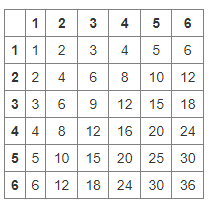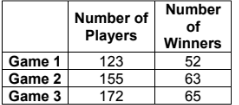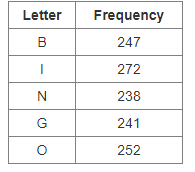You are spinning a spinner with 10 equal sized sections. 5 of the sections are red, 2 are blue, 1 is green, 1 is yellow, and the last is orange. What is the theoretical probability that the spinner will land on blue or yellow?
3/10 or 30%
In a game, the probability of correctly guessing which of 5 boxes contains a tennis ball is 1/5. About how many winners would be expected if 60 people play the game?
12
What is the probability model for choosing from a hat with the names Lisa, Andrew, Mike, Jack, Jack and Sue.
Remember - probability models must contain TWO things (check your notes for Lesson 9-4 if you don't remember).
{Lisa, Andrew, Mike, Jack, Jack, Sue}
P(Lisa) =1/6
P(Andrew) = 1/6
P(Mike) = 1/6
P(Jack) = 1/3
P(Sue) = 1/6
A coin is tossed 300 times and lands on heads 175 of those. What is the theoretical probability of the coin landing on heads (as a simplified fraction and a percent)?
Remember the theoretical probability only looks at the activity (in this case the coin), so the data about what happened doesn't matter.
1/2 or 50%
20 marbles are placed into a bag. 6 are red, 2 are blue, 4 are green, 3 are yellow and 1 is orange. 200 people chose a marble randomly and had the following results, 45 were red, 50 were blue, 20 were green, 55 were yellow and 30 were orange. What is the difference between how many red were expected to be drawn and how many actually were?
15 marbles
There were 6/20 red theoretically there should have been 60 red out of the 200 drawn.
There were actually 45/200 drawn. So the difference between 60 and 45 is 15.
How many outcomes are there if you flip a coin and spin a five section spinner?
Use a list, table or tree to determine what all of the outcomes are.
10
A bag contains 14 green, 12 orange and 19 purple tennis balls. Create a probability model for choosing a tennis ball from the bag.
Remember - a probability model contains TWO things (if you don't remember what they are check your lesson 9-4 notes).
{14 green, 12 orange 19 purple}
P(Green)=14/45
P(Orange)=12/45
P(Purple)=19/45
The yearbook club is handing out t-shirts to its members. There are 5 blue, 7 green, 9 red, and 4 yellow T-shirts in all. If Jacob is handed a T-shirt, what is the probability that the color is red?
9/25
What is the relative frequency of the wheel landing on 3?

9/40 or 22.5%
In a survey, 125 people were asked to choose one card out of five cards labeled 1 to 5. The results are shown in the table. Compare the theoretical probability and the experimental probability of choosing a card with the number 1. 
Theoretical probability is 1/5 or 20%
Experimental Probability is 15/125 or 12%
Theoretical Probability is greater.
To play a game, a number cube with sides numbered 1 through 6 is rolled and a fair coin is flipped. Use a table, tree diagram or list or represent the sample space.
What is the probability of flipping a head and rolling either a 3 or a 5? Write a percent rounded to the nearest tenth.
16.7%
A bag contains 14 green, 12 orange and 19 purple tennis balls. Suppose a tennis ball is randomly selected and then replaced 75 times. How many orange tennis balls do you expect?
20
There are 12 out of 45. So 12/45. Use a cross multiplication model to find the prediction for how many that would be out 75.
12/45 =x/75
The table shows the outcomes of rolling two number cubes at the same time and finding the product of the two numbers.
If Abby rolls two number cubes three hundred times, about how many times would she expect a product greater than 10?
About 142 times
Hal records the number of winners of 3 Ring Toss games in the table.

Based on the data, how many winners should Hal expect if there are 750 players?
300
A game has 15 balls for each of the letters B, I, N, G, O. The table shows the results of drawing a ball 1,250 times.

For which letter is the experimental probability closest to the theoretical probability?
O
The theoretical probability of each letter is 1/5 so 20% (this is because there are 15 balls all together and 5 of each, so 5/15 simplifies to 1/5)
The experimental probability of B is 247/1250,which is 19.76%
The experimental probability of I is 272/1250, which is 21.76%
The experimental probability of N is 238/1250, which is 19.04%
The experimental probability of G is 241/1250, which is 19.28%
The experimental probability of 0 is 252/1250, which is 20.16%.
20.16% is closest to 20%, therefore B has the closest theoretical and experimental probability.
Four people - Rob, Sonja, Jack and Ang - enter their names into a drawing. The winner receives either a t-shirt or a mug, and which prize they receive is randomly selected. What is the probability that either Ang wins and is given a mug, or Jack wins and is given either prize? Please create a table, list or tree diagram for this problem.
3/8 or 37.5%
A spinner has six equal-sized sections numbered 1, 1, 2, 3, 3, and 4. What is the sample space for the spinner, and what is the probability of spinning a 3?
{1, 1, 2, 3, 3, 4}
P(3) =
1/3